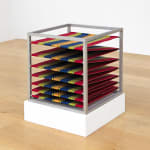

Alighiero Boetti Italian, 1940-1994
Zig Zag, 1967
Aluminium and fabric
50 x 50 x 50 cm; (19 3/4 x 19 3/4 x 19 3/4 in.)
Copyright The Artist
Alighiero Boetti's Zig Zag, 1967, exemplifies the artist's innovative engagement with everyday materials and his pivotal role in the Arte Povera movement. Measuring 50 x 50 x 50 cm, this...
Alighiero Boetti's Zig Zag, 1967, exemplifies the artist's innovative engagement with everyday materials and his pivotal role in the Arte Povera movement. Measuring 50 x 50 x 50 cm, this sculpture is the smallest in a series of four created between 1966 and 1968, with volumes ranging from 50 to 75 cubic centimetres. Notably, the initial trio, varying from 50 to 54 cubic centimetres, debuted at Boetti's inaugural solo exhibition at Galleria Christian Stein in Turin in January 1966. A subsequent, more compact version of 20 cubic centimetres followed in 1968.
Zig Zag features an aluminium frame across which a single strip of striped fabric, reminiscent of deck-chair material, is stretched in a zigzag pattern, supported by eight metal rods ascending in proportional increments. This configuration epitomises Boetti's concept of 'dysfunctional design', wherein he transforms commonplace objects and materials – often sourced from hardware stores – into aesthetically compelling yet non-utilitarian forms. By extending the formal logic of familiar designs, Boetti challenges conventional notions of functionality and art.
This work aligns with Boetti's involvement in the Arte Povera movement between 1966 and 1968. Arte Povera, or 'poor art', emerged in Italy during the late 1960s, with artists utilising every day or organic materials to challenge traditional art forms. Boetti's use of humble materials and his focus on the relationship between chance and order are characteristic of this movement. Reflecting on this period, Boetti remarked: “In the winter of '65-66 I prepared an immense amount of works and projects. By about May '66, convinced it was impossible to use every day practical objects, I tackled some new abstract works.” This statement underscores his transition from utilising practical objects to exploring abstract forms, leading to creations like Zig Zag.
Zig Zag also serves as a playful critique of Colour Field abstraction and Minimalism's preoccupation with the grid and the artwork as a 'specific object'. “Sculpture or the object never interested me” said Boetti in an interview with Mirella Bandini in 1973. Boetti's insertion of fabric associated with working-class leisure into a precise cubic structure subverts the sleek aesthetics of 1960s Italian design, which often favoured moulded plastics. This juxtaposition can be interpreted as a response to both the classic Minimalist cube and contemporary Italian chair design. The work mimics the folding structure of a deckchair; however, unlike a functional deckchair, the folds here do not serve a practical purpose. Instead, they suggest an 'absurd endlessness', inviting viewers to trace the stripes back and forth indefinitely.
Zig Zag represents a significant phase in Boetti's artistic evolution, marking his experimentation with new material possibilities and his turn to daily life as a source of artistic investigation. It signifies the culmination of his involvement with Arte Povera and the beginning of a broader aesthetic exploration, focusing on grids, sequences, language, and patterns of order and disorder – a trajectory that would be inaugurated by the hand-drawn grid in his series Cimento dell'armonia e dell'invenzione (1969).
Zig Zag features an aluminium frame across which a single strip of striped fabric, reminiscent of deck-chair material, is stretched in a zigzag pattern, supported by eight metal rods ascending in proportional increments. This configuration epitomises Boetti's concept of 'dysfunctional design', wherein he transforms commonplace objects and materials – often sourced from hardware stores – into aesthetically compelling yet non-utilitarian forms. By extending the formal logic of familiar designs, Boetti challenges conventional notions of functionality and art.
This work aligns with Boetti's involvement in the Arte Povera movement between 1966 and 1968. Arte Povera, or 'poor art', emerged in Italy during the late 1960s, with artists utilising every day or organic materials to challenge traditional art forms. Boetti's use of humble materials and his focus on the relationship between chance and order are characteristic of this movement. Reflecting on this period, Boetti remarked: “In the winter of '65-66 I prepared an immense amount of works and projects. By about May '66, convinced it was impossible to use every day practical objects, I tackled some new abstract works.” This statement underscores his transition from utilising practical objects to exploring abstract forms, leading to creations like Zig Zag.
Zig Zag also serves as a playful critique of Colour Field abstraction and Minimalism's preoccupation with the grid and the artwork as a 'specific object'. “Sculpture or the object never interested me” said Boetti in an interview with Mirella Bandini in 1973. Boetti's insertion of fabric associated with working-class leisure into a precise cubic structure subverts the sleek aesthetics of 1960s Italian design, which often favoured moulded plastics. This juxtaposition can be interpreted as a response to both the classic Minimalist cube and contemporary Italian chair design. The work mimics the folding structure of a deckchair; however, unlike a functional deckchair, the folds here do not serve a practical purpose. Instead, they suggest an 'absurd endlessness', inviting viewers to trace the stripes back and forth indefinitely.
Zig Zag represents a significant phase in Boetti's artistic evolution, marking his experimentation with new material possibilities and his turn to daily life as a source of artistic investigation. It signifies the culmination of his involvement with Arte Povera and the beginning of a broader aesthetic exploration, focusing on grids, sequences, language, and patterns of order and disorder – a trajectory that would be inaugurated by the hand-drawn grid in his series Cimento dell'armonia e dell'invenzione (1969).
1
of
37

